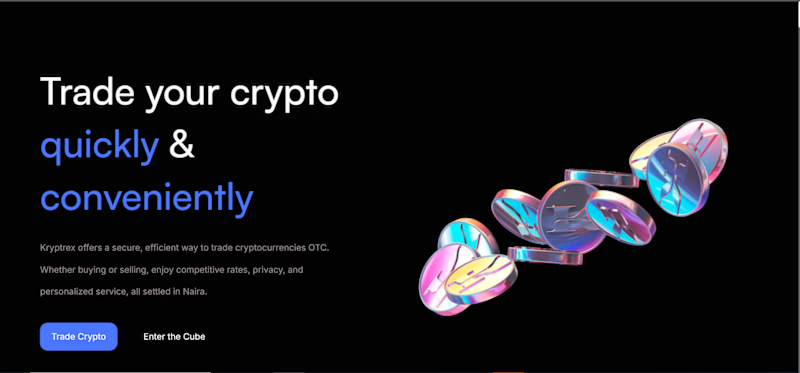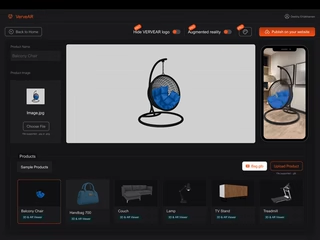Kryptrex. Crypto OTC, efficient and secure.

Kenneth Madukwe
Visual Designer
UX Designer
Product Designer
Figma
Framer
Product walkthrough
1. Context and Background
Industry: Cryptocurrency and OTC (Over-the-Counter) trading have grown as critical platforms for large-scale traders seeking discreet and high-volume transactions without affecting market pricing. Kryptrex OTC Exchange operates within this specialized space, focusing on high-net-worth individuals and institutions. The platform required a secure, user-centric website to facilitate private, large-scale cryptocurrency trades, establishing trust in a competitive and evolving digital finance market.
Market Conditions: The rapid expansion of cryptocurrency markets increased the demand for secure, high-capacity trading platforms. OTC exchanges, in particular, need to mitigate the potential volatility impact caused by large trades on traditional exchanges.
External Factors: Legal and financial regulations, such as KYC (Know Your Customer) and AML (Anti-Money Laundering) standards, are essential for operating in the financial sector, impacting the platform's security and compliance requirements.
2. Central Characters and Stakeholders
Key Stakeholders:
Kryptrex Development Team: Responsible for implementing the security, functionality, and design aspects of the platform, ensuring compliance with security regulations and user needs.
End Users (Traders and Institutions): Large-scale cryptocurrency investors and institutions who require security, privacy, and a seamless experience.
Regulatory Authorities: Regulatory bodies imposing KYC/AML compliance, essential for legal operation within financial jurisdictions.
Brand and Marketing Teams: Tasked with ensuring the brand's credibility and user trust, aligning the platform’s aesthetic and functional elements with Kryptrex's market reputation.
3. Situation and Complications
Key Events and Challenges:
Challenge of Displaying Real-Time Data: The platform needed to manage and display vast cryptocurrency data streams efficiently, without impacting performance or user experience.
Security and Compliance Pressures: Maintaining compliance with KYC/AML while also prioritizing user trust and security required a strategic design approach to minimize friction during secure logins and transactions.
Balancing UX with High-Level Security: The user experience had to integrate security measures such as secure login flows and encryption cues (e.g., padlock icons) without overwhelming the interface.
4. Problems and Dilemmas
Performance vs. Data Intensity: Integrating real-time data visualization in a way that does not hinder performance was crucial. This required efficient handling of large data sets through techniques like lazy loading and optimized API calls.
User Trust vs. Security Complexity: Enhancing security often complicates user experience. Kryptrex faced the challenge of making security features clear without creating a barrier to usability.
Brand Consistency vs. Functionality: Aligning the design to Kryptrex's brand identity, with a clean and credible look, needed to be balanced against the functional requirements of a data-intensive, interactive platform.
5. Solutions and Alternatives
Responsive Design Across Devices: Ensuring full adaptability of the design for desktop and mobile devices was achieved using Framer’s component-based system, with a strong emphasis on mobile breakpoints.
Optimized Real-Time Data Handling: The implementation of lazy loading and optimized API calls allowed large data sets to load efficiently, maintaining responsive performance for end-users.
Visual Security Cues: Security elements were visually embedded, such as padlock icons for encryption and clear signposting for privacy policies and KYC/AML compliance, helping reassure users of the platform's security without intrusive pop-ups or lengthy explanations.
6. Suggested Solutions and Alternatives
Enhanced User Experience through Data-Driven Interface: By utilizing dynamic components for real-time pricing and trading volumes, the interface became both data-intensive and user-friendly, leveraging Framer’s Motion library for smooth, engaging animations.
Custom Code Integrations: Tailoring React components specifically for user interaction panels, account management, and live chat support provided a highly customizable and intuitive experience for high-volume traders.
Content Management via Property Controls: The backend team was empowered with property controls for managing content and layout tweaks, adding flexibility without needing continuous development input.
7. Evaluate Outcomes and Consequences
Short-Term Benefits: The newly designed Kryptrex website received positive user engagement and brand perception feedback upon launch, establishing immediate credibility in the OTC crypto market.
Long-Term Value: The responsive, scalable design positions Kryptrex to adapt quickly to future market changes or expanded functionality, ensuring sustained usability and performance.
Risk of Data Management: Efficiently handling large data sets mitigated risks associated with slow load times, but ongoing maintenance of lazy loading and API optimizations will be necessary as data volumes grow.
8. Recommendations and Decisions
Chosen Solution: The combined approach of a responsive, data-driven interface with security-focused design elements effectively meets Kryptrex’s needs for usability, brand alignment, and compliance.
Implementation Strategy: Continued use of Framer’s Motion library for engaging visualizations and backend property controls for easy updates. Establishing a monitoring system for the data components will maintain efficient performance as data volumes increase.
Ethical and Compliance Alignment: Reinforcing security and privacy measures visually aligns with legal standards and supports user trust, essential in an industry where security breaches can significantly impact brand reputation.
9. Key Learnings and Takeaways
Data Optimization for User Experience: Leveraging advanced techniques like lazy loading can handle high-frequency data streams without compromising user experience.
Balancing Security with Usability: Integrating subtle security cues allows for a streamlined user experience while maintaining trust, a crucial factor in cryptocurrency platforms.
Brand-Centric Design in Data-Heavy Interfaces: Consistency in design, aligned with brand identity, is achievable even with complex data requirements when using component-based design systems.
10. Closure and Follow-Up
Further Improvements: Additional testing to ensure scalability and responsiveness as the platform's user base grows. Exploring more advanced real-time data management solutions to handle increasing trading volume.
Future Case Studies and Training: Implementing follow-up studies on user engagement and security performance post-launch can provide valuable insights for iterative improvements.
Additional Resources: Training for backend and UX teams on maintaining security updates and responsive design features, ensuring the website remains both secure and efficient as technology and user expectations evolve.

Product Hero section




